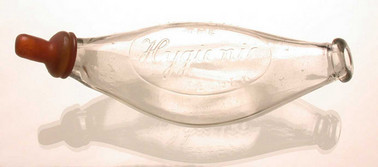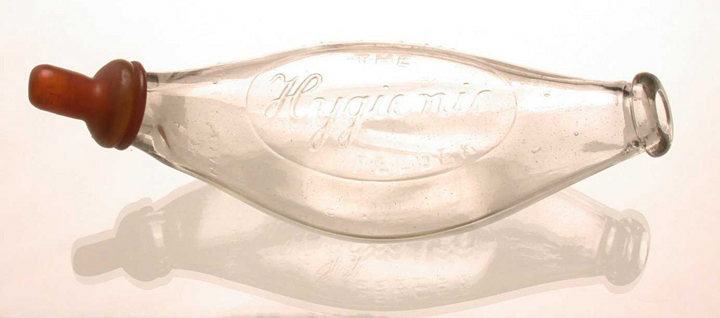Baby Bottle, Victorian-Edwardian, Original
Until the late 19th century babies feeding equipment was difficult to clean and therefore very unhygienic. In 1894 the first 'banana' shaped feeder, the Allenburys' feeder, appeared on the market. It was made by the partnership of Allen and Hanburys and was marketed as being 'most easily cleansed'. It quickly became popular. Other companies soon followed the example. The bottle shown here is the Hygienic feeder. The bottle is made out of clear moulded glass and has a flat base to keep it stable on a surface. It is boat shaped and fits neatly into one hand, allowing the other hand to support the baby. At one end of the bottle there is a hole for pouring in the feeding mixture. To prevent it from pouring out, a metal cap is put on after filling. At the other end a similar hole, covered by a rubber teat, lets the baby suck out the feed. The baby needs a teat to regulate the flow of liquid into its mouth, so it doesn't drink too fast and choke.
The words The Hygienic Feeder are moulded onto the top of the bottle. This brand name emphasises the growing awareness of hygiene and cleanliness. This design of baby's bottle proved so popular that it sold well into the 1950s.
The words The Hygienic Feeder are moulded onto the top of the bottle. This brand name emphasises the growing awareness of hygiene and cleanliness. This design of baby's bottle proved so popular that it sold well into the 1950s.

Length:19cm
The Victorian period saw the development of patent medicines and medical products manufactured by companies in Britain and the United States of America. Companies realised there was a need for these products, and that there was also the need, in a competitive marketplace, to advertise and convince members of the public that their products were superior.
Cleanliness was a vital marketing ingredient, as both the medical profession and the public were beginning to realise that cleanliness and hygiene were important aspects of health care. And there was a growing awareness that, rather than becoming ill and then seeking a cure, trying not to become ill in the first place was a better idea, so preventative measures, such as keeping fit, and cleanliness were on the public health agenda.
The Allenburys' Feeder was marketed on how simple it was to keep clean. There are no difficult to clean areas, especially inside the feeder, that might remain dirty and thus upset the baby's health.
"Without the manifold defects of the old fashioned tube feeder, it is most easily cleaned." British Medical Journal
"We know of no other feeder so simple, so easy to keep in order." The Practitioner
The recommendations quoted above were used as part of the advertising campaign giving serious medical backing for the product.
To compliment the feeder, Allenburys provide foodstuffs suitable for the first year in a baby's life. A special milk food will help "develop firm flesh and strong bones, and represent the simplest and most successful method of infant feeding".
Allenburys' Rusks were "a valuable addition to baby's diet when ten moths old and after. Prepared from specially selected flours rich in muscle forming constituents and in appearance resemble crisp toast biscuits. When eaten dry the Rusks mechanically aid the cutting of teeth."
A special 'Allenburys Diet' food is recommended for invalids, dyspeptics and the aged. "A complete concentrated food prepared from pure rich milk and whole wheat in a partially pre-digested form. It is easy of digestion and can be made immediately by adding boiling water only."
Allenburys also produced, and marketed on the packaging, baby soap and an antiseptic nursery powder guaranteed to "promote the healing of chaps or abrasions and keep the child's skin sweet and wholesome."
Cleanliness was a vital marketing ingredient, as both the medical profession and the public were beginning to realise that cleanliness and hygiene were important aspects of health care. And there was a growing awareness that, rather than becoming ill and then seeking a cure, trying not to become ill in the first place was a better idea, so preventative measures, such as keeping fit, and cleanliness were on the public health agenda.
The Allenburys' Feeder was marketed on how simple it was to keep clean. There are no difficult to clean areas, especially inside the feeder, that might remain dirty and thus upset the baby's health.
"Without the manifold defects of the old fashioned tube feeder, it is most easily cleaned." British Medical Journal
"We know of no other feeder so simple, so easy to keep in order." The Practitioner
The recommendations quoted above were used as part of the advertising campaign giving serious medical backing for the product.
To compliment the feeder, Allenburys provide foodstuffs suitable for the first year in a baby's life. A special milk food will help "develop firm flesh and strong bones, and represent the simplest and most successful method of infant feeding".
Allenburys' Rusks were "a valuable addition to baby's diet when ten moths old and after. Prepared from specially selected flours rich in muscle forming constituents and in appearance resemble crisp toast biscuits. When eaten dry the Rusks mechanically aid the cutting of teeth."
A special 'Allenburys Diet' food is recommended for invalids, dyspeptics and the aged. "A complete concentrated food prepared from pure rich milk and whole wheat in a partially pre-digested form. It is easy of digestion and can be made immediately by adding boiling water only."
Allenburys also produced, and marketed on the packaging, baby soap and an antiseptic nursery powder guaranteed to "promote the healing of chaps or abrasions and keep the child's skin sweet and wholesome."

Length:19cm

Until the late 19th century babies feeding equipment was difficult to clean and therefore very unhygienic. In 1894 the first 'banana' shaped feeder, the Allenburys' feeder, appeared on the market. It was made by the partnership of Allen and Hanburys and was marketed as being 'most easily cleansed'. It quickly became popular. Other companies soon followed the example. The bottle shown here is the Hygienic feeder. The bottle is made out of clear moulded glass and has a flat base to keep it stable on a surface. It is boat shaped and fits neatly into one hand, allowing the other hand to support the baby. At one end of the bottle there is a hole for pouring in the feeding mixture. To prevent it from pouring out, a metal cap is put on after filling. At the other end a similar hole, covered by a rubber teat, lets the baby suck out the feed. The baby needs a teat to regulate the flow of liquid into its mouth, so it doesn't drink too fast and choke.
The words The Hygienic Feeder are moulded onto the top of the bottle. This brand name emphasises the growing awareness of hygiene and cleanliness. This design of baby's bottle proved so popular that it sold well into the 1950s.
The words The Hygienic Feeder are moulded onto the top of the bottle. This brand name emphasises the growing awareness of hygiene and cleanliness. This design of baby's bottle proved so popular that it sold well into the 1950s.




















